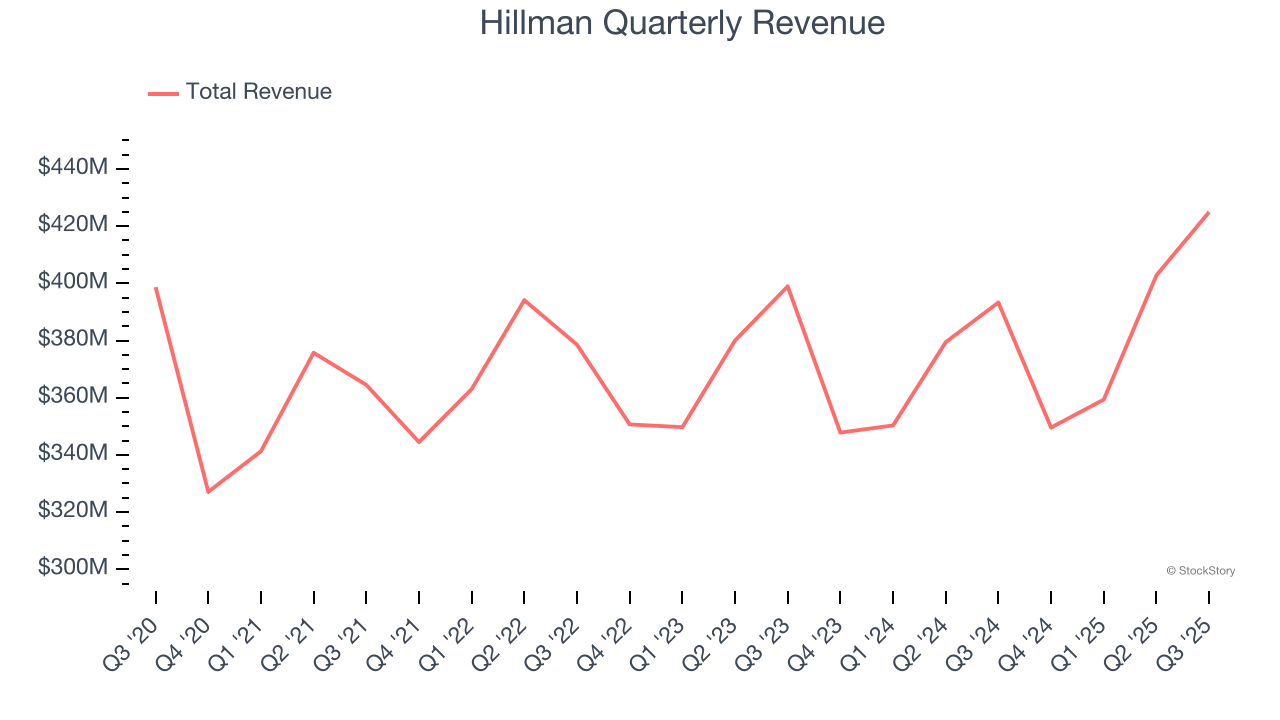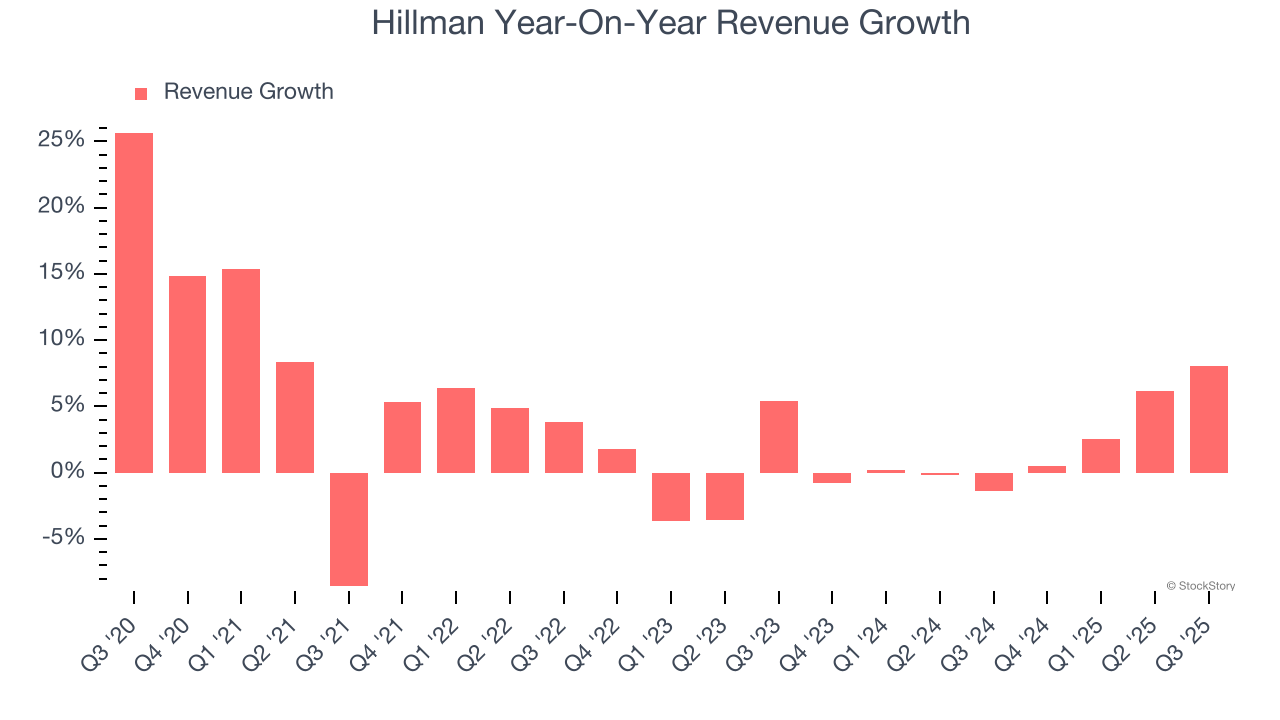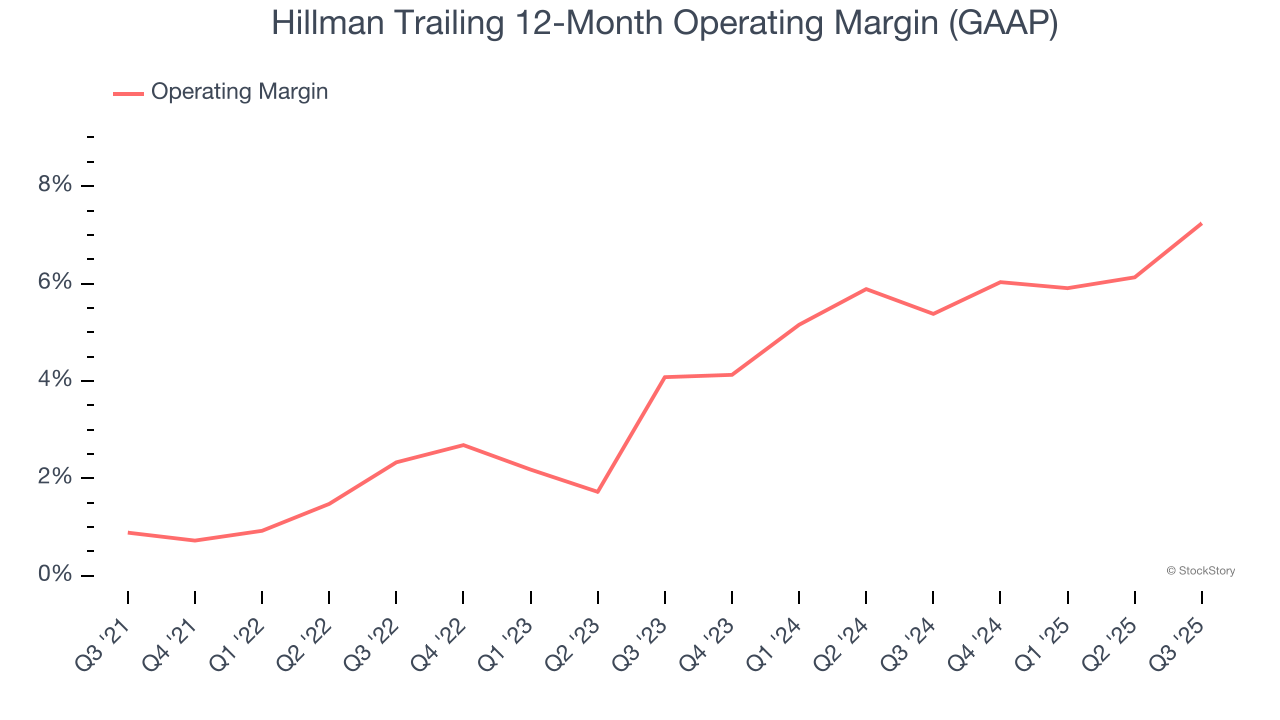
Hardware products and merchandising solutions provider Hillman (NASDAQ: HLMN) met Wall Streets revenue expectations in Q3 CY2025, with sales up 8% year on year to $424.9 million. On the other hand, the company’s full-year revenue guidance of $1.56 billion at the midpoint came in 0.6% below analysts’ estimates. Its non-GAAP profit of $0.22 per share was 7.6% above analysts’ consensus estimates.
Is now the time to buy Hillman? Find out by accessing our full research report, it’s free for active Edge members.
Hillman (HLMN) Q3 CY2025 Highlights:
- Revenue: $424.9 million vs analyst estimates of $425.7 million (8% year-on-year growth, in line)
- Adjusted EPS: $0.22 vs analyst estimates of $0.20 (7.6% beat)
- Adjusted EBITDA: $88.03 million vs analyst estimates of $81.53 million (20.7% margin, 8% beat)
- The company reconfirmed its revenue guidance for the full year of $1.56 billion at the midpoint
- EBITDA guidance for the full year is $272.5 million at the midpoint, in line with analyst expectations
- Operating Margin: 10.8%, up from 6.8% in the same quarter last year
- Free Cash Flow Margin: 2.1%, down from 10.1% in the same quarter last year
- Market Capitalization: $1.83 billion
"During the quarter, we generated the highest Net Sales and Adjusted EBITDA in the 61-year history of Hillman," commented Jon Michael Adinolfi, President and CEO of Hillman.
Company Overview
Established when Max Hillman purchased a franchise operation, Hillman (NASDAQ: HLMN) designs, manufactures, and sells industrial equipment and systems for various sectors.
Revenue Growth
A company’s long-term sales performance is one signal of its overall quality. Any business can put up a good quarter or two, but the best consistently grow over the long haul. Regrettably, Hillman’s sales grew at a sluggish 3% compounded annual growth rate over the last five years. This fell short of our benchmarks and is a poor baseline for our analysis.

We at StockStory place the most emphasis on long-term growth, but within industrials, a half-decade historical view may miss cycles, industry trends, or a company capitalizing on catalysts such as a new contract win or a successful product line. Hillman’s recent performance shows its demand has slowed as its annualized revenue growth of 1.9% over the last two years was below its five-year trend. 
This quarter, Hillman grew its revenue by 8% year on year, and its $424.9 million of revenue was in line with Wall Street’s estimates.
Looking ahead, sell-side analysts expect revenue to grow 8.4% over the next 12 months, an improvement versus the last two years. This projection is above the sector average and indicates its newer products and services will spur better top-line performance.
The 1999 book Gorilla Game predicted Microsoft and Apple would dominate tech before it happened. Its thesis? Identify the platform winners early. Today, enterprise software companies embedding generative AI are becoming the new gorillas. a profitable, fast-growing enterprise software stock that is already riding the automation wave and looking to catch the generative AI next.
Operating Margin
Hillman was profitable over the last five years but held back by its large cost base. Its average operating margin of 4% was weak for an industrials business. This result is surprising given its high gross margin as a starting point.
On the plus side, Hillman’s operating margin rose by 6.4 percentage points over the last five years, as its sales growth gave it operating leverage.

This quarter, Hillman generated an operating margin profit margin of 10.8%, up 4 percentage points year on year. The increase was encouraging, and because its operating margin rose more than its gross margin, we can infer it was more efficient with expenses such as marketing, R&D, and administrative overhead.
Earnings Per Share
Revenue trends explain a company’s historical growth, but the long-term change in earnings per share (EPS) points to the profitability of that growth – for example, a company could inflate its sales through excessive spending on advertising and promotions.
Hillman’s EPS grew at an astounding 85.2% compounded annual growth rate over the last five years, higher than its 3% annualized revenue growth. This tells us the company became more profitable on a per-share basis as it expanded.

We can take a deeper look into Hillman’s earnings to better understand the drivers of its performance. As we mentioned earlier, Hillman’s operating margin expanded by 6.4 percentage points over the last five years. This was the most relevant factor (aside from the revenue impact) behind its higher earnings; interest expenses and taxes can also affect EPS but don’t tell us as much about a company’s fundamentals.
Like with revenue, we analyze EPS over a more recent period because it can provide insight into an emerging theme or development for the business.
For Hillman, its two-year annual EPS growth of 29.8% was lower than its five-year trend. We still think its growth was good and hope it can accelerate in the future.
In Q3, Hillman reported adjusted EPS of $0.22, up from $0.16 in the same quarter last year. This print beat analysts’ estimates by 7.6%. Over the next 12 months, Wall Street expects Hillman’s full-year EPS of $0.59 to shrink by 4.5%.
Key Takeaways from Hillman’s Q3 Results
We liked how Hillman beat analysts’ EBITDA and EPS expectations this quarter. On the other hand, its full-year revenue guidance slightly missed. Overall, this print was mixed. The market seemed to be hoping for more, and the stock traded down 1.4% to $9.17 immediately following the results.
Big picture, is Hillman a buy here and now? We think that the latest quarter is only one piece of the longer-term business quality puzzle. Quality, when combined with valuation, can help determine if the stock is a buy. We cover that in our actionable full research report which you can read here, it’s free for active Edge members.






